Fishermen Call Foul on Cod Count
continued from Homepage
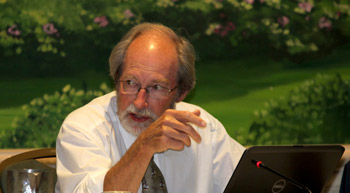
Dr. David Pierce, MA Department Marine Fisheries. Pierce on the council’s voting down the emergency action on cod 10/01/14 said, “The council has shown no courage in this vote. Now we will have to offer up something. We will have to lobby the regional administrator (John Bullard), because the decision will now be in his (National Marine Fisheries Service) hands. Fishermen’s Voice photo
“This industry is a shell of what it used to be,” said commercial fisherman Kevin Scola. “When people are selling their boats and can’t make a living, you’ve got a problem. These guys are a mainstay of the industry. You’re not looking at the big picture.” Scola continued, “You’ve destroyed the lives of a tremendous amount of people and families. You’ve ruined this industry….If it’s as bad as you say, then it’s time to shut this down.”
“Consider this premeditated murder of the inshore fleet of Massachusetts and New Hampshire,” said Paul Vitale, a Gloucester fisherman. Vitale continued, “There’s no need for rolling closures. The TACs [total allowable catches] alone are so damn low we’re just scraping by….If you want the inshore fleet out, buy us out, or let us fish.”
“This is a disaster,” said commercial fisherman Philip Michaud. Michaud and others said the problems go back to the establishment of the catch-share sector program that was implemented in 2010. “Sectors made a few real big winners and lot of losers,” said Michaud. “I think people saw money to be made, and they played this system. And they got themselves access to that cod and they collapsed it. It wasn’t global warming. It was new players, big boats and big effort, no accountability of what was being removed….This is a public resource. Now it’s been privatized. “
“This action is a slap in the face,” said Kevin Norton, a Scituate, Mass., dragger. “You’ve got lot of small fishermen, guys fishing alone, family boats, just figuring out a way not to lose everything in the past few months, and now you throw this in our laps. A secret cod assessment no fishermen knew about.” Norton continued, “I’ve done everything that you guys asked me to do. I’m going to lose my business and my house because of bad science. I’ve got four small children.”
Another fisherman said the NEFMC is basically managing a collapse. “A different rulebook applies when you’re looking at numbers so low,” he said, adding that species imbalance and disease will ultimately send the fishery into full collapse. “We’re almost there,” he said. “The Newfoundland stock collapsed, and we can, too.”
“I want to talk about the humans who have been and will be affected by these regulations,” said Angela Sanfilippo, president of the Fishermen’s Wives Association and executive director of the Massachusetts Fishermen’s Partnership. “This system has created great poverty in the states of Massachusetts and New Hampshire. Myself and my staff deal every day with people losing their homes. They don’t have rent money, no food money, can’t go to a doctor. We’ve been doing the dirty work that comes out of the system. I oppose this emergency closure because it will make it worse. Right now, the coffers are empty. The last few years have been horrible. I’ve seen more fishermen and fishermen’s wives cry on the other side of my desk than I can remember.” Sanfilippo said the folks who started in the industry young are now in their 60s, hoping to retire. “But what can they get? They made very little money….They are the humans who have carried this industry for 400 years. They are suffering and they’re poor and they have no place to go.”
A Gulf of Maine Atlantic Cod assessment update, conducted this past summer by the Northeast Fisheries Science Center (NEFSC) in Woods Hole, Mass., says the stock continues to be overfished and overfishing is occurring.
Spawning stock biomass (SSB) in 2013 is estimated to be below 2,500 metric tons (mt), the lowest ever estimated. The estimate is just 3-4 percent of the SSB’s maximum sustainable level, which is calculated to be 47,184 mt or 69,621 mt, depending on which model scientists are using.
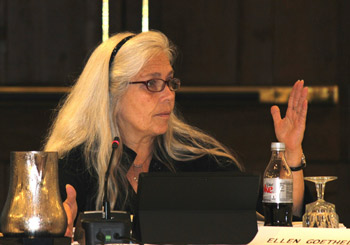
Ellen Goethel, NEFMC member, said, “Cod is not the top species. Why close cod and any species that interact with it? Many more people than are in this room will be affected, but they will have nothing to say about this decision. I find the whole process absurd.” Fishermen’s Voice photo
Fishing mortality is estimated to be more than 6 times greater than maximum sustainable fishing levels.“Fishing mortality is near all-time highs despite the fact that fishery catches are at the lowest levels in the time series,” the assessment says. “The Gulf of Maine cod stock is in poor condition.”
For the current, 2014 fishing year, the allowable catch level of 1,550 mt, which was set by fishery managers through a three-year specification process, exceeds the updated overfishing threshold.“Fishing year 2015 catches would have to be substantially decreased to avoid exceeding” overfishing levels, the assessment says.
To rebuild spawning stock by 2024, the 2015 catch would need to be reduced considerably lower than 1,550 mt, the assessment says.
The assessment also saw a truncated age structure in the GOM cod stock. That is, there is a lack of older-aged fish, as well as lower overall abundance and decreased weight-at-age for the older ages in the population. There have also been changes in the spatial distribution of cod.
Assessment models originally expected the 1,550 mt acceptable biological catch (ABC), with a corresponding annual catch limit (ACL) of 1,470 mt, to produce a low fishing mortality in 2014. The ACL is divided between the commercial fishery’s sector program and common pool; and the recreational fishery.
As a result of the updated assessment, NEFMC’s Scientific and Statistical Committee (SSC), on Sept. 24, advised the NEFMC to set an overfishing limit (OFL) of 514 mt for 2015, 2016 and 2017. The current OFL is 2,639 mt.
SSC recommended reducing the ABC from 1,550 mt to 200 mt.
The SSC also requested estimates of incidental, non-target bycatch of GOM cod under prevailing operating conditions. The SSC said there was some uncertainty in the data, and so, additional information might justify an increase of the ABC anywhere up to 514 mt.
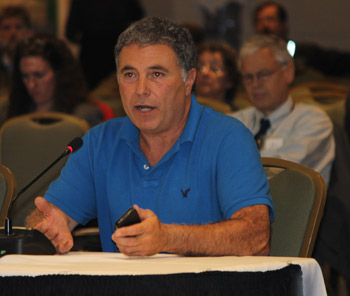
Vito Giacalone, Northeast Seafood Coalition. Giacalone told the federal regulators in response to the updated assessment’s inevitable impact and the condition of ground fishing, “You are the people who ruined this fishery.” Fishermen’s Voice photo
But, the SSC added, “It is important to bear in mind that the OFL of 514 mt would not change in light of these requested analyses and sets an upper bound for the final ABC.”
The SSC is essentially seeking information from the industry about how much GOM cod it would need as a bycatch fishery, in order to continue to catch healthy stocks. SSC asked NEFMC’s groundfish and recreational advisory panels to provide input on the level of incidental, non-target bycatch, as well as new fishing strategies that might result in reductions of catch.
“It was our intention to review the information with a mind that, after discussion, were we to determine it was warranted, we would adjust up from the 200 metric tons,” said SSC member Jason McNamee. McNamee added, “The uncertainty is not just it could be worse than we think. It also could be better than we think.”
A NEFMC member said that, if SSC pursues that new information without following a strict set of information-gathering and analysis protocols, it risks going down a political rather than scientific path.“I’m concerned about the SSC path,” said NEFMC member Michael Sissenwine.“It’s moving closer to policy than science.”
The goal is to rebuild the stock in 10 years, by 2024. However, said the SSC, the ABC recommendation addresses the possibility that rebuilding cannot be achieved within 10 years, even with no fishing. The 200 mt level of fishing is based on incidental bycatch, including a reduction in bycatch rate, and would not allow direct fishing on GOM cod.
The majority of the Gulf of Maine cod catch comes from an increasingly contracted region of the western GOM.
“The biggest uncertainty is the uncertainty of the SSC over what to do,” said NEFMC member David Preble. “Where did 200 metric tons come from? There doesn’t seem to be any firmness. It’s like jello nailed to a wall.”Preble said the stock’s truncated age structure is alarming. “We can’t recover the fish on a small amount of three-, four-, five-year-old fish. If we don’t do something serious about the spawning and the recruitment, and foster the growth of the larger spawners, then does it matter if it’s 200 tons or 500 tons?”
“Any uncertainty with the age structure is problematic,” said McNamee, who added, “We’re in a zone at a population level that is so low that the uncertainties around it overwhelm the magnitude of the stock that exists.”
“I don’t think we can just give 200 metric tons, pat it on its butt, and send it on its way,” responded Preble. “I think we have to do more….Spawning closures will get us a bigger bang for the buck on a devastated fishery.”
In light of the depletion of inshore spawning aggregations, the NEFMC’s groundfish committee introduced the motion for an emergency action to establish spawning area protections.
NEFMC learned in August that the NEFSC had updated the GOM cod assessment. The update was not scheduled to be completed until 2015. A memo by NEFMC’s groundfish committee said NEFMC was unaware the assessment was being updated ahead of schedule. The memo said a number of groundfish committee members were “concerned about process and an apparent lack of transparency in this update,” whose timing is normally a matter of public information. According to NEFSC officials, NEFSC’s goal was to examine an alternative assessment process, and GOM cod was merely the test subject.
NEFSC director William Karp, in a Sept. 19 letter to the NEFMC, said the summer’s GOM cod assessment “was part of an exercise to improve the processing of assessment information and was neither planned nor scheduled. Furthermore, we did not provide advance notice that this would be carried out. The results raised serious concerns regarding the declining condition of the stock, and I felt the gravity of the situation left us with only one course of action – to bring it to your attention irrespective of the potential negative consequences.”
But Richard Canastra, representing fishermen in New Bedford and Gloucester, and a member of NEFMC’s groundfish advisory panel, moved to reject the updated assessment, calling it fundamentally flawed both procedurally and scientifically. “By springing a surprise assessment on the public, the science center has further alienated those scientists and fishing communities who are concerned about the lack of transparency and collaboration,” Canastra said. “The breakdown in process increases the level of mistrust between government and fishing communities.”
Another fisherman asked the NEFMC, “What if you’re wrong? There’s no contingency plan for if you’re wrong. You’re looking at destroying the inshore fleet.”
Fisherman and former NEFMC member David Goethel said, about the assessment, “This doesn’t meet the ‘best available science’ standard. The update was conducted in secret by only a handful of handpicked people…We need experienced fishermen involved in the stock assessment far more than they are now.”
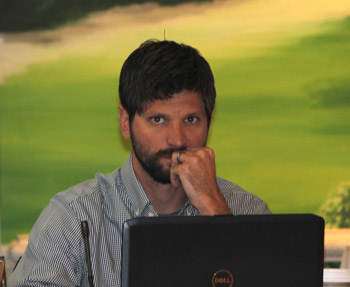
Tom Dempsey, Cape Cod Fishermen’s Alliance. Dempsey referred to the cod as being a sock in collapse. He also spoke of collecting data on cod mortality in lobster traps as more important based on the recent updated assessment. Fishermen’s Voice Photo
Goethel said he opposed the emergency action. “Fishermen in the Gulf of Maine were tried and convicted by their own government,” Goethel said. He said that he didn’t doubt that the scientists who performed the assessment genuinely believe the results. However, he said, “What’s described in the document is not being seen on the water.” He said the assessment overly relies on trawl surveys and incorporate little fishermen-dependent data. One data index – catch per unit of effort – cannot be used, he said, because the high price of leased fish in many stocks has prevented fishermen from buying them and filling their quotas. “This is misinterpreted as lack of fish,” Goethel said.
Salvatore Di Stefano, chief administrative officer for Gloucester, and speaking for Gloucester mayor Carolyn Kirk, said the city opposed the proposed emergency action to close spawning areas. “This is the fishing grounds for the Gloucester day boat fishery,” said Di Stefano, who called the proposal a knee-jerk reaction that would be a direct hit on the Gloucester fishing community. In addition, he said, no one has had a chance to examine where discrete closures that reflect actual spawning activity should be.
The SSC was criticized for failing to consider possible environmental impacts, such as warmer water driving cod north, ocean acidity, and other environmental factors, that could be influencing the assessment. Karp said, “We recognize that many of these things could be affecting the [cod] stock, but we don’t have the ability to isolate these individual effects on cod. We seek an understanding of these linkages, and many other scientists are also seeking an understanding of these legitimate concerns.”
In a letter to NEFMC, the Northeast Hook Fisherman’s Association in Portsmouth, N.H., wrote “We propose the reason for the surveyed drop in GOM cod stocks was directly attributable to the record high climate temperatures and associated GOM record warm water temperatures for the winter 2012 and 2013 year. The normal cyclic ecology of the GOM was disrupted.
Goethel said any assessment model must consider temperature variables. “Gulf of Maine water is too hot,” he said. “Fish vote with their tails. They swim far enough away to find a water temperature they can live in, or they die. I think some of them swam away, or they died. I think we’ve got to investigate this before we proceed further, without saying it’s all fishing mortality. It’s not.”
Goethel continued, “You’ve misidentified the problem. Fishing is irrelevant at this point. Cod are not doing well because they’re being parboiled.”
Brett Tolley, a community organizer with the Northwest Atlantic Marine Alliance, said the proposed action doesn’t acknowledge underlying problems such as seals, dogfish, and water temperature.
A groundfish committee member encouraged the NEFSC to examine environmental influences on stocks, to see if environmental influences could be affecting fish stocks and recruitment of cod.
Fishery advocates asked NEFMC to think outside the box. Jackie O’Dell, executive director of the Northeast Seafood Coalition, said any discussion of spawning closures should be carefully considered, and not implemented through an emergency action. “The industry has come forward with a host of projects they recommended” such as using different types of trawls, O’Dell said. “I’m concerned that we’re recommending spawning closures that haven’t gone through that thoughtful process. Spawning closures need to be through a deliberate action that involve the industry and are small, discrete, dynamic, and are closely monitored so we know we’re getting the benefit that we’re supposed to be getting out of these areas.”
Jim Odlin, a commercial boat owner in Portland, said the problem with GOM cod has been going on for at least a generation. “There are major fisheries in the Gulf of Maine that have very little interaction with Gulf of Maine cod, and you have to do everything you can to allow those fisheries to go forward,” Odlin said, citing redfish, pollock, hake, dabs, and gray sole as examples of healthy stocks. “You need to let those fisheries be prosecuted or there will be nothing, and there will be no infrastructure.”
Odlin added. “We had big rolling closures for 10 years. We need to think outside the box.”
Goethel said, “Cod spawning areas are usually small, in the 20 square mile range. Cod and other species like haddock need protection during spawning. They have rituals that are easily disrupted by intrusive actions from things like fishing gear. However, the areas the agency is discussing are not all cod spawning areas. The area they are talking about is also much too large. It is approximately 1,800 square miles. Effectively, this will end commercial day boat fishing from Provincetown to Portland. Recreational fishing by six-passenger party boats will end also.”
Josh Wiersma, director of New Hampshire Community Seafood, said the New England groundfish fishery “is not actually in a state of emergency. I think that term just makes for good press. The quota sector system works well” to maintain fishing effort at a rational pace. “What you’re talking about now is abandoning all faith in a system you put in place,” said Wiersma. “At the first sign of trouble with this cod stock, fleet diversity won’t mean anything….Sectors are hard, but effort control under a hard TAC is much worse. Sectors protect low-abundance stocks. Effort controls on top of that would ruin the system.”
Wiersma continued, “Is inshore Gulf of Maine cod worth it? Will it ever repopulate? We have a seal population of half a million, and now great white sharks. The fishery is changing and may never come back.” Losing the ability to fish on healthy groundfish stocks, to protect one stock that is “over-romanticized,” doesn’t make sense, he said. “What happens when Gulf of Maine cod doesn’t comes back in 10 years? Are you willing to destroy everything else we built? In 10 years, who will be left to catch them?”
“We can fish and not catch Gulf of Maine cod,” said Joe Orlando, a Gloucester fisherman who is on the Northeast Seafood Coalition board and president of Sector 2. “Of course we should close certain areas for spawning, but let’s figure out exactly where they are.”
Another Gloucester fisherman said, “A lot of us made significant financial commitments to fish out this fishing year, and to throw a roadblock in the middle of an operation is pretty irresponsible. I don’t think this would be allowed in any other industry in the country.”
“I understand the need of the council to act,” said Frank Marachi, a commercial fisherman from Scituate, Mass., and a member of Northeast Sector 10, “but I also understand the national standards that protect fishing communities and safety of life at sea have been a condition of practicability. There needs to be a balance. I don’t see a balance here. I see the measure in motion being excessive.”
Marachi said that fishermen who have leased their annual catch entitlement will have to fish very quickly, before closures take effect, “thus risking their lives and overloading the market. The pathway forward is to begin to better delineate closed areas necessary to protect spawning. I think fishermen agree this is necessary, but the information doesn’t exist to do that.” Marachi said fishermen should be able to develop fisheries that are not cod-dependent through the amendment process.
Rick Beal, a Gloucester fisherman, said GPS and tracking technology now exist, making it possible to delineate specific closures, rather than the big closures of the past. “I’ve been doing this since 1966,” Beal said. “My generation has treated it with the respect it deserves the following generation will do the same thing.”
Maggie Raymond, executive director of Associated Fisheries of Maine, said the proposed 200 mt is operationally impractical. “Two hundred tons may as well be zero,” said Raymond.
Charter/party boat operators also had a lot to say about the proposed measures.
Captain Michael Pierdinock, a charter boat captain in Green Harbor, Mass., and director of the Stellwagen Bank Charter Boat Association, asked NEFMC not to close areas to fishing for healthy groundfish stocks, such as haddock and pollock. To do so, he said, would drive charter boats to travel 40 miles out, which customers don’t want to do.
Bill Wagner, a charter boat owner out of Rye, N.H., said closing the western GOM would put charter boats out of business. He said the industry has the capability to target healthy stocks without catching cod.
Tim Rider from Saco, who fishes both commercially and recreationally, said “It will be a death sentence for party boats….So leave the western Gulf of Maine open to party and charter boats on a limited scale.”
In a memo, NEFMC member David Pierce said he supported spawning area protections: “Up to now, we’ve been guided by three-year-old 2011 information and assumptions about what might have happened in 2012 and 2013. ACLs [annual catch limits] were set accordingly and we projected ahead to 2014, 2015 and 2016.”
Although some fishermen say “cod are everywhere and in areas where they have been absent in recent years,” Pierce wrote, “It seems quite clear that what many of us have feared finally has occurred – a collapse or near-collapse of the GOM cod stock. Some might not want to use ‘collapse’ because of its implications for management and the fishery. I suggest collapse, rather than ‘depleted,’ is appropriate especially because recruitment has been well below that median for least the last four years; there is no age structure offering any realistic hope for rebuilding and stock structure is even more disrupted (i.e., continued diminishment and loss of spawning aggregations). Adding to this more alarming descriptor is the likely impact of warming waters and their effects on productivity.”
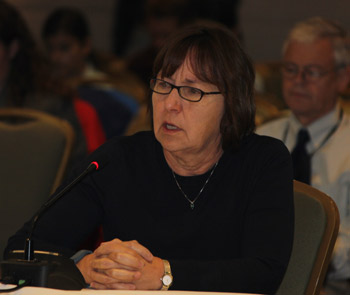
Maggie Raymond. The proposed 200 mt is operationally impractical. Two hundred tons may as well be zero. Fishermen’s Voice Photo
Pierce continued, “Whatever is left of the GOM cod stock remnant must be protected, especially the remaining pre-spawning and spawning aggregations that likely now may be very few in number and size. There is no choice for us but to dramatically reduce effort and mortality in ways giving us a greater chance of success, i.e., closures that can be enforced rather than dependence on a far lower, difficult to monitor and enforce ACL. A much-reduced ACL will not prevent focused fishing on aggregated cod frequenting nearshore grounds, including sector fishermen acquiring GOM cod through leasing from fishermen with a catch history from other GOM regions, i.e., not the southwestern portion of GOM.”
National Marine Fisheries Service chief John Bullard called measures to date, “too little, too late. The long-term history of this iconic stock, Gulf of Maine cod, is tragedy. It’s a collapse. Those numbers are headed to zero. And it looks like they won’t take too much more time to get to zero….This is what we have presided over. The agency takes responsibility for participating in this failure. And I think the council needs to take responsibility, and the industry needs to take responsibility, too, because the industry influences our decisions.”
Bullard said GOM cod is already a bycatch fishery, and the bycatch already exceeds 200 mt. “There’s no way in the world 200 tons allows it to be a bycatch fishery. It’s too low to do that,” Bullard said. “And in all probability, it’s too high to rebuild the stocks.”
Others supported the proposed measures.
Peter Shelley, senior counsel with the Conservation Law Foundation, said the emergency action is “necessary and overdue.” Shelley said, “The council managed this fishery into a box canyon. We’re looking at bad news and worse news.” While there might be young spawners, he said, there aren’t enough to rebuild the resource, and changing environmental conditions may be worsening the situation. “The issue here, unlike the SSC’s concern about what the industry needs to get by, is, what do the cod need to start recruiting at a higher level than the last five-year average?” said Shelley. “You have consistently and erroneously picked the highest catch you could….There’s no reason to believe the 200 metric tons is not too high also.”
Judd Crawford, a science and policy manager with Pew Charitable Trust, said there are grounds for emergency action, and said the proposed measures didn’t go far enough. “The emergency we face, with Gulf of Maine cod being in a very depleted state, both in abundance and characteristics of the population, is not something that just happened,” Crawford said. “It’s something that’s been happening as result of a whole range of decisions over many years. The results speak for themselves. We need to take approaches that are not the standard ones we’ve taken before….There needs to be a plan to bring fishing mortality way down and to greatly improve the ability of fish to spawn, and to create more safe havens for fish that are older so we can recover the age structure of the population.”
Ultimately, said NEFMC member Mary Beth Tooley, “There’s a lot of question about whether the stock can rebuild by 2024. What’s the SSC’s confidence level that it can? Some information says it can, and other information says it can’t….That information is going in two different directions. We have to act regardless, and it’s quite frustrating and difficult.”
NEFMC will take up the matter again at its Nov. 18-20 meeting.
To read the complete “Fishers’s Knowledge” document by P. Macdonald, see link at fishermensvoice.com at the end of this article.
